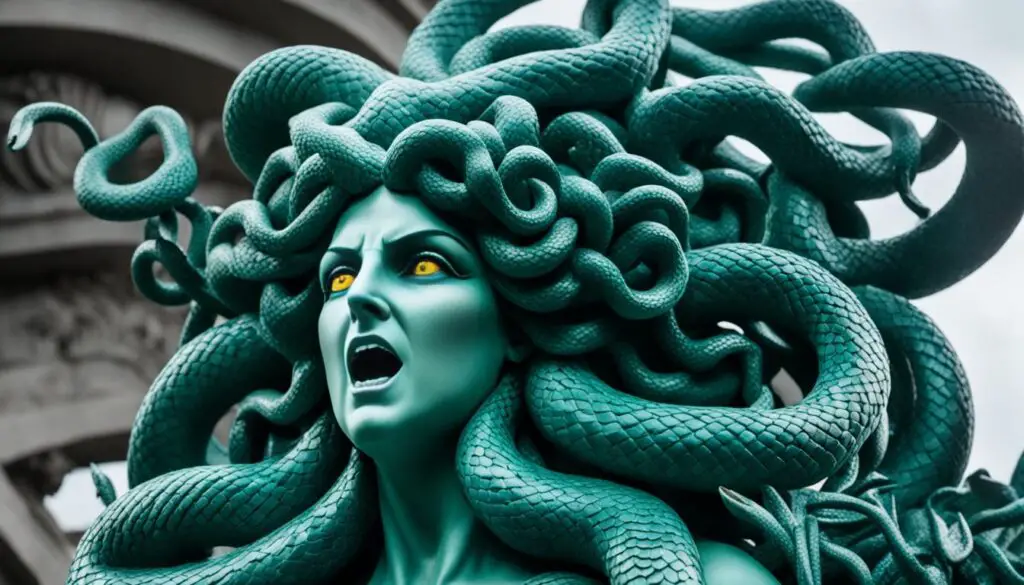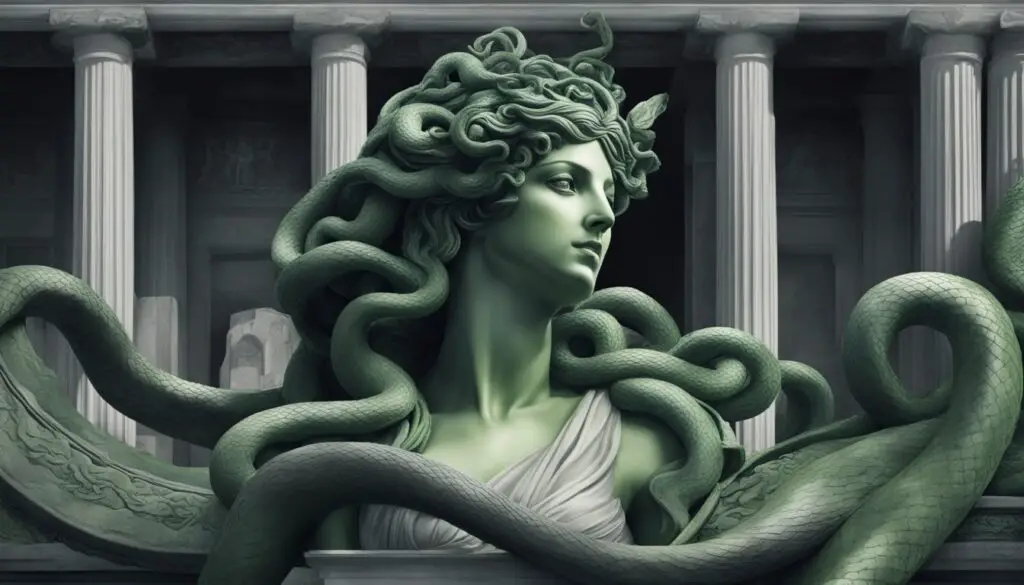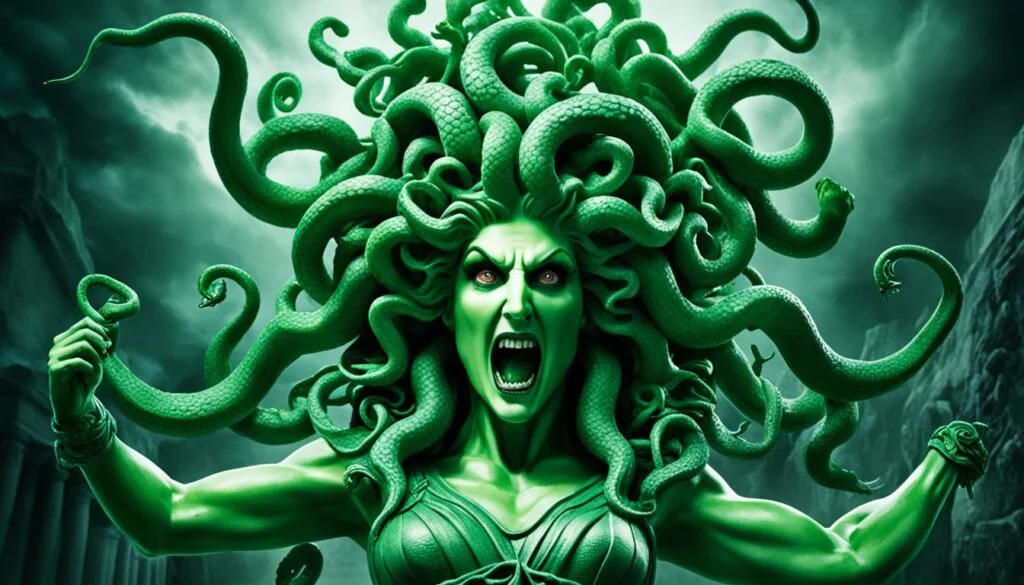Medusa is a key figure in Greek mythology with snake hair and a killing gaze. She was mortal, unlike her sisters Stheno and Euryale, due to her parentage.
Phorcys and Ceto, her parents, are credited with children such as The Hesperides and The Graeae.
The tale of Medusa is tied to stories of bravery and heroism, especially with Perseus.
While once a terror, Medusa’s character has evolved into a mix of beauty and fear. This change in her representation explores themes of protection and revenge, adding depth to Greek myths.
Key Takeaways
- Medusa is described as a woman with snake-covered hair, whose gaze could turn anyone into stone.
- She is the only mortal among her Gorgon sisters, Stheno and Euryale.
- The hero Perseus beheaded Medusa, subsequently using her head as a powerful weapon.
- Medusa was originally a beautiful maiden transformed into a monster by Athena in Greek mythology.
- Medusa’s blood is said to have created corals in the Red Sea and vipers in the Sahara.
Introduction to Medusa
Medusa is more than just a myth; she symbolizes heroism and beauty twisted into something monstrous.
From ancient Greek Mythology, the story of Medusa has influenced our culture. It’s not just a tale; it is a part of our collective imagination.
Medusa: The Infamous Gorgon
In Greek myths, Medusa was part of the Gorgon sisters, along with Stheno and Euryale. Born to sea gods, she was the only mortal among them.
Medusa’s story is not just about her looks but also her deadly stare that could turn anyone to stone.
The Key Facts About Medusa
At first, Medusa was a beautiful maid known for her long hair and soft skin. But Athena, a major goddess, made her look like a monster.
This change shows more than just a shift in her looks. It hints at deeper stories too.
The story changes when Medusa meets Perseus, son of Zeus. He is sent to kill her. With guidance from Athena, he uses a special sickle to cut off her head.
Even after her death, her head could still turn people into stone.
This story has inspired many retellings. The Medusa Safari Ltd.’s Mythical Realms Collection is one example. Her legacy lives on through books, art, and movies.
Medusa’s Origins in Greek Mythology
Medusa’s story is deeply tied to Greek mythology. Her parentage and connections with other mythical beings are key. To understand Medusa, we must look at these family ties and what they mean in the old tales.
Parentage and Family Background
She came from sea deities Phorcys and Ceto. They were the children of Gaia and Pontus. This makes Medusa part of a royal line in Greek mythology.
Interestingly, she was mortal while her sisters, the Gorgons, were immortal.
The Gorgon Sisters: Medusa, Stheno, and Euryale
Medusa had two sisters, Stheno and Euryale. They formed the group known as the Gorgon sisters.
In Hesiod’s Theogony, these three were feared for their looks and power. Unlike the others, Medusa faced a unique and tragic destiny.
Her change from a beautiful woman to a Gorgon was Athena’s doing. It’s a story of beauty turned curse.
This twist in her tale deepens our view of Medusa. It explains part of her fame in Greek myths.
The Metamorphoses by Ovid tells how Poseidon played a role in Medusa’s fate. It mixes beauty, tragedy, and immense power.
This combination makes Medusa a memorable figure in Greek myth. It shows the many layers of her story.
Medusa’s Transformations: From Beauty to Beast
Medusa was once a beautiful young woman. But, her story changed when Neptune (Poseidon) became infatuated with her.
This led her to Athena’s temple. Athena, angered by the act in her sacred space, cursed Medusa. This turned her lovely hair into serpents, starting her tragic change.
The Curse by Athena
Medusa’s tale starts with her as a lovely maiden. Neptune’s interest drew her into Athena’s temple, where she was cursed by Athena.
This resulted in her hair becoming a tangle of venomous snakes. Beauty turned to monstrosity, marking a pivotal shift in Medusa’s story.
The Symbolism of Medusa’s Transformation
Medusa’s change from beauty to beast is fraught with symbolism, reflecting themes of power, fear, and change.
Early artworks mostly depicted her as horrifying. But, Greek artists from 480 to 323 BCE began to humanize her, showing the dual nature of beauty and horror.
More than half of the artworks in the Dangerous Beauty exhibit at the Met reflect this complex image.
Athenian pottery from 450–440 BCE shows one of the first views of Medusa as not a monster but a mere mortal.
Madeleine Glennon delves into this shift, noting how Medusa’s mystery remained, even with changing portrayals.
Newer works, like Luciano Garbati’s sculpture, show her in a powerful, victorious light. This challenges old fears and brings new meanings to Medusa’s symbolism today.
Who Was Medusa?

Medusa is a key figure in *Greek mythology*. She, along with her sisters Stheno and Euryale, is known as a Gorgon.
Unlike her immortal siblings, Medusa was mortal, which made her different and vulnerable.
Details of Medusa’s Appearance
Medusa is easily recognized. Her head is covered with live, moving snakes instead of hair. If you looked at her eyes, you’d turn to stone.
This power both frightened and intrigued people.
Over time, artists have shown Medusa in different ways. Some made her look like a terrifying monster, while others found her attractive.
She is usually drawn with a wide face, big eyes, and snakes for hair. This makes her very well-known in *greek mythology medusa* tales.
The Mortal Gorgon Among Immortals
One of the most important facts about Medusa is that she could die. This made her more relatable to human beings.
Her story is not just about someone terrifying; it’s also about facing challenges and being overcome by them.
Her mortality led to her meeting with Perseus. He was able to defeat her using a shield to not look directly at her.
This action where Perseus killed Medusa is a major event in Medusa’s history.
After her death, two new characters came into being from her blood. Pegasus, the famous winged horse, and Chrysaor, the hero with a golden sword.
This connects Medusa’s story with other important Greek mythology tales.
Even though there were no temples solely for Medusa, her image was worshiped in other ways. For example, her face appeared at a temple of Artemis and a rock near Red Beach in Crete.
Her image was believed to offer protection. Medusa has inspired many artists over the years, showing how deeply her story has influenced our culture.
The Story of Medusa and Perseus
One of the most fascinating tales from Greek mythology is about Perseus and his big battle with Medusa. This story has been loved by many for ages.
It mixes action, gods helping humans and big ideas about life. But how did Perseus, who was he really, and why did he face the fearsome Gorgon, Medusa?
The Quest Given to Perseus
Perseus was the son of Zeus and a human, Danae. He was no normal dude; he was smart and strong.
His story got really interesting when the evil King Polydectes wanted something dangerous. Polydectes had his eye on Danae and bossed Perseus into getting Medusa’s head.
This mission was to save his mom from marrying the king.
How Perseus Slew Medusa
Medusa was the only Gorgon sister not immortal and was very scary. Athena had even turned Medusa into a monster.
Perseus got some cool gear from the gods: a helmet of invisibility, flying shoes, a shiny shield, and a sharp sword.
He used Athena’s shield to see Medusa’s reflection, so he wouldn’t turn to stone. This trick was his key to winning.
Perseus was brave and smart. While Medusa slept, he cut off her head. It was a huge win for him, showing everyone his courage and skill.
He didn’t stop there. He used Medusa’s head to help other people and get back at the king. He turned the king to stone, freeing his mom.
The story of Medusa and Perseus is about being brave and looking out for family. It’s a big part of Greek myths, teaching lessons to anyone who listens.
This tale has been praised for thousands of years, both for its teachings and the amazing heroes in it.
The Aftermath of Medusa’s Beheading

The story of Medusa’s beheading by Perseus left a lasting impact on Greek mythology. It brought both fear and marked new beginnings for many.
Perseus’ Use of Medusa’s Head
In Greek mythology medusa, Perseus did something unexpected after killing Medusa. He didn’t just throw her head away. He used it as a weapon.
Medusa’s look had the power to turn people into stone even after she died. Perseus used this power to defeat his enemies by turning them into statues.
Later, he gave Medusa’s head to the goddess Athena.
Athena put it on her shield, the Aegis, to strike fear in her foes. This story shows how Medusa’s influence lived on in a strange but powerful way.
It shows the mix of beauty and horror in her story.
The Birth of Pegasus and Chrysaor
After Medusa was beheaded, something amazing happened. From where her head fell, Pegasus the winged horse, and Chrysaor, a giant with a golden sword, were born.
Poseidon was their father.
This shows a contrast in Medusa’s tale. While she brought fear, her story also brought new life and heroes.
Medusa’s facts highlight these themes of creation versus destruction and life versus death.
Even now, Medusa’s myth is a powerful part of Greek folklore. Her story, from its tragic end to the birth of Pegasus and Chrysaor, keeps shaping our view of myth.
It shows the blend of gods and men, and how her story affects both.
Medusa’s Role in Ancient Greek Art
Medusa’s image is a big deal in Greek art. It shows her story from myth to iconic symbol. Over time, these pictures mix fear, sadness, and protection.
Her face is both scary and fascinating, influencing artists for years.
Depictions of Medusa Over Time
Art has shown Medusa in many ways throughout history. For example, the Gorgoneion was on items from the Etruscan and Roman times.
These included terracotta antefixes and bronze finials. They show how Medusa’s image was flexible and common in art.
Later, a Medusa ornament from the 1st-2nd centuries A.D. and a 1st century A.D. mosaic were made.
These pieces highlight her story’s sad parts, showing her pain clearly.
Bernini’s Medusa sculpture from 1644-1648 stands out. It shows the moment she turns to stone, showing Athena’s curse and art together.
Alexander Runciman’s 1774 etching reveals her weak side, focusing on her myth’s power dynamics.
Franz Von Stuck’s 1892 painting, on the other hand, sees Medusa as mystical.
Medusa’s Image on Shields and Armor
Medusa, especially her head, was a big symbol of shields and armor in Greek myths. Warriors used the Gorgoneion to protect themselves.
It was key on Athena’s shield, mixing fear with safety. Soldiers in Greek and Roman times put it on their armor too.
Luciano Garbati’s sculpture “Medusa with the Head of Perseus” from 2008 marks a cultural change.
It relates to the #MeToo movement and women’s empowerment. This art shows Medusa as strong and in charge.
Garbati’s work supports a new view of Medusa, focusing on her power and resilience over her monster side.
Medusa’s Symbolism in Greek Culture

Medusa’s impact on Greek culture goes deep into their myths. She is remembered for her scary face and strong story, playing a key role.
Her image was seen as both protective and empowering in ancient Greece.
An Apotropaic Symbol
Medusa was often used as a symbol of evil. Her face, with snakes for hair and a deadly stare, could be found on many things.
These included Greek pottery, jewelry, and even Athena’s shield. People believed she could keep them safe from harm.
Medusa’s image was widely spread, known for protecting against bad spirits.
Medusa as a Feminist Icon
Today, Medusa stands for female strength. She was first a beautiful woman cursed by the gods.
However, turning into a Gorgon, she became a symbol of feminist power. The story of Medusa is now seen as a tale of getting stronger, not just a tragic event.
This new view highlights women’s power and the fight against unfair treatment.
The Metropolitan Museum of Art has even had shows like “Dangerous Beauty: Medusa in Classical Art.”
These events focus on her new role. The story of Medusa lets us think about women’s roles and power in different ways.
Medusa in Roman Mythology
The story of Medusa wasn’t just popular in Greece. It also had a big impact on Roman mythology.
Roman poets, like Ovid, shared new ways of looking at Medusa’s sad story. Their insights caught the hearts of many and helped make Medusa a lasting figure.
Ovid’s Influence on Medusa’s Story
Ovid’s take on Medusa is quite unique. He tells us she started as a beautiful woman but changed because of a curse from Athena.
He adds a twist by saying she was turned ugly after being wronged by Poseidon in Athena’s temple.
This version adds layers to Medusa’s story. It shows us her as more than just a monster but as a victim of unfair fate.
Differences Between Greek and Roman Versions
Greek and Roman tales show Medusa in different lights. Greek myths focus more on her monster side and her part in Perseus’ adventure.
Meanwhile, Roman stories offer a more compassionate view of Medusa’s story.
These cultural shifts are clear in how artists over the years have represented Medusa. Greek art shows her as scary, but Roman art often shows her as more human and sad.
The ongoing changes in her story and images highlight her lasting impact on mythology.
The Geographic Variations of Medusa’s Legend
Medusa’s story always interests scholars, who look into where she came from. Many ancient writers give different areas where her story could be from.
This adds many flavors and ideas to Medusa’s tale. Some places in these stories are very special.
Medusa’s Alleged Residences
Herodotus suggests Medusa lived near Sarpedon. This shows how her story can adapt in different ways.
Some say her roots are in North Africa, in Libya. This highlights how her myth spread to many places.
Pindar called Medusa “fair-cheeked,” bringing beauty to how we think of her story. This is very different from Aeschylus’ frightening view.
Aeschylus talks about the Gorgons, including Medusa, as beings so scary that anyone seeing them would die.
Medusa’s story is told in many places, showing its wide influence. These different locations show how important the story of Medusa is in various cultures.
The search for who Medusa was keeps going, sparking discoveries.
Medusa’s Influence on Modern Culture
Medusa has left a lasting mark on modern culture, influencing art, literature, and media.
Many famous artists throughout history have depicted her. They showcased her lasting intrigue and Medusa symbolism.
Even today, her image captivates people, showing up in mythology books and other places.
Today, Medusa’s face is the logo for Versace, mixing ancient myth with today’s fashion.
Her influence can be seen in media, from anime like One Piece to comics. Wonder Woman, she’s been a part of the story since 1964.
The 1981 movie “Clash of the Titans” also made her a major character, using cool special effects.
Medusa’s story also speaks to issues today. She’s been reimagined as a figure against victim-blaming and sexual assault.
Actresses like Uma Thurman have played her, raising questions about how women are shown in the media.
The hashtag #me(dusa) also links her myth with the #metoo movement, shedding light on current gender issues.
Recent books, including Rosie Hewlett’s “Medusa”, examine these themes, making her story stay relevant.
Movies like “Photocopier” and “Black Medusa” talk about patriarchy through the lens of Medusa.
These new interpretations continue to make Medusa a symbol of power, linking ancient myths with modern culture.
Psychological Interpretations of Medusa

The story of Medusa is a key point in psychoanalysis, with many interpretations.
Sigmund Freud suggested in 1940 Medusa’s image deals with castration fear.
He thought Medusa’s ability to turn people to stone showed a mix of beauty and horror.
This created an “uncanny” feeling, something both familiar and scary.
From a different view, Jung saw Medusa’s look as the anima. This is the hidden feminine side that can stop a man’s growth.
Freud and Jung both noted the symbolism of Medusa in their different ways. They found a connection between basic desires and the need to control them.
Freud’s Psychoanalytic Perspective
Freud looked deeply into fears tied to mothers and women. He believed Medusa’s face, with its snake hair, could scare men.
He thought this was because it represented unseen female strength and ability, making men anxious.
This idea is still studied today and backed up by people like Hélène Cixous.
Medusa’s Symbolism in Psychoanalysis
Psychoanalysis finds Medusa’s story is about mistreatment and its effects. Her tale includes being raped and then turned into a monster.
This represents how damaging uncontrolled desires and power can be. It also sees Medusa as an intense mix of attraction and fear, capturing the complexity of human feelings.
Today, some, especially feminists, see Medusa as a symbol of power and rebirth. They agree with Hélène Cixous, who says we should see Medusa as showing hidden women’s abilities.
To learn more, looking at Medusa’s symbolism can show how her myth speaks to both old and new concerns of power and who we are.
Literary Interpretations of Medusa
Medusa’s story has captivated many, leading to fresh takes in literature. She represents a mix of beauty, might, and fear.
In Iris Murdoch’s A Severed Head, Medusa’s tale is key. It shows how people wrestle with their inner demons and unseen dangers.
Medusa in Modern Literature
Modern stories about Medusa often touch on today’s issues. Medusa is a symbol of complex thoughts and clashing beliefs in Prevelakis’s works.
And it’s not just in books; poets and authors add new layers to her myth, like in Fly on the Wall Press’s books.
They show Medusa in a way that sparks conversations about mythologies and who we are.
Medusa in Modern Feminist Criticism
In feminist views, Medusa stands up against male-driven rules. She’s a symbol of fighting back and changing the story.
This connects with movements like #MeToo, which aims to end oppression. Sarah Wallis’s Medusa retold tells Medusa’s tale in a modern light.
It talks about who we are and the struggle against being pushed down.
Medusa in Visual Arts
Medusa’s myth has long inspired artists. Since ancient times, she has been depicted in various ways, from terrifying to human-like.
This shows themes of beauty, horror, and change in art beautifully.
Historical Art Depictions
Ancient Greek art shows Medusa as a scary monster. During the Renaissance, artists like Caravaggio painted her alive and dead.
Peter Paul Rubens made a dramatic painting of her severed head.
In the 19th century, she inspired even more art. Arnold Böcklin’s painting in 1878 is famous. Over time, Medusa went from a dangerous to a tragic figure in art.
Medusa in Modern Art
Today, Medusa is seen as more than just a monster. Artists like Harriet Hosmer and Alice Pike Barney made her more human.
Her image is still common in art, fashion, and movies.
Medusa can be scary or sympathetic, showing her depth in art. She remains a key figure, showing up in various art forms today.
Frequently Asked Questions
What is the real story behind Medusa?
The real story behind Medusa is that she was originally a beautiful maiden who served as a priestess in Athena’s temple. According to myth, she was raped by Poseidon in Athena’s temple, and Athena, in anger, transformed her into a Gorgon with snakes for hair, making her so hideous that anyone who looked at her would turn to stone.
Why did Athena curse Medusa?
Athena cursed Medusa because she was desecrated in Athena’s temple by Poseidon. As punishment, Athena transformed Medusa into a Gorgon, a monster with snakes for hair, whose gaze could turn people to stone.
Who was Medusa to Poseidon?
Medusa was a lover of Poseidon. In one version of the myth, Poseidon raped Medusa in Athena’s temple, which led to Athena cursing Medusa and transforming her into a Gorgon.
What was Medusa most known for?
Medusa is most known for her appearance as a Gorgon with snakes for hair and her ability to turn anyone who looked directly at her into stone. She is a prominent figure in Greek mythology and a symbol of monstrous transformation.
Is Medusa good or evil?
Medusa is often portrayed as a villainous figure due to her monstrous appearance and deadly gaze. However, she can also be seen as a victim of the gods’ whims and injustices, which adds complexity to her character.
What was the worst thing Medusa did?
The worst thing Medusa did, according to mythology, was turn people to stone with her gaze. This power was a result of Athena’s curse and not an act of Medusa’s own volition.
What are 5 facts about Medusa?
1. Medusa was originally a beautiful maiden and a priestess of Athena. 2. She was transformed into a Gorgon by Athena as punishment. 3. Medusa’s gaze could turn people to stone. 4. She lived on an island called Sarpedon. 5. Medusa was eventually slain by the hero Perseus, who used her head as a weapon.
What is Medusa’s symbol?
Medusa’s symbol is her head with snakes for hair. This image is often used to represent her and is also seen on shields and armor in mythology, particularly the aegis of Athena and Zeus.
Who was Medusa in love with?
Medusa was in love with Poseidon, the god of the sea. Their relationship led to her transformation into a Gorgon after they desecrated Athena’s temple.
How were Medusa’s kids born?
Medusa’s children, Pegasus (the winged horse) and Chrysaor (a giant), were born from her neck when Perseus beheaded her. According to the myth, they sprang forth fully formed from the blood of Medusa.




